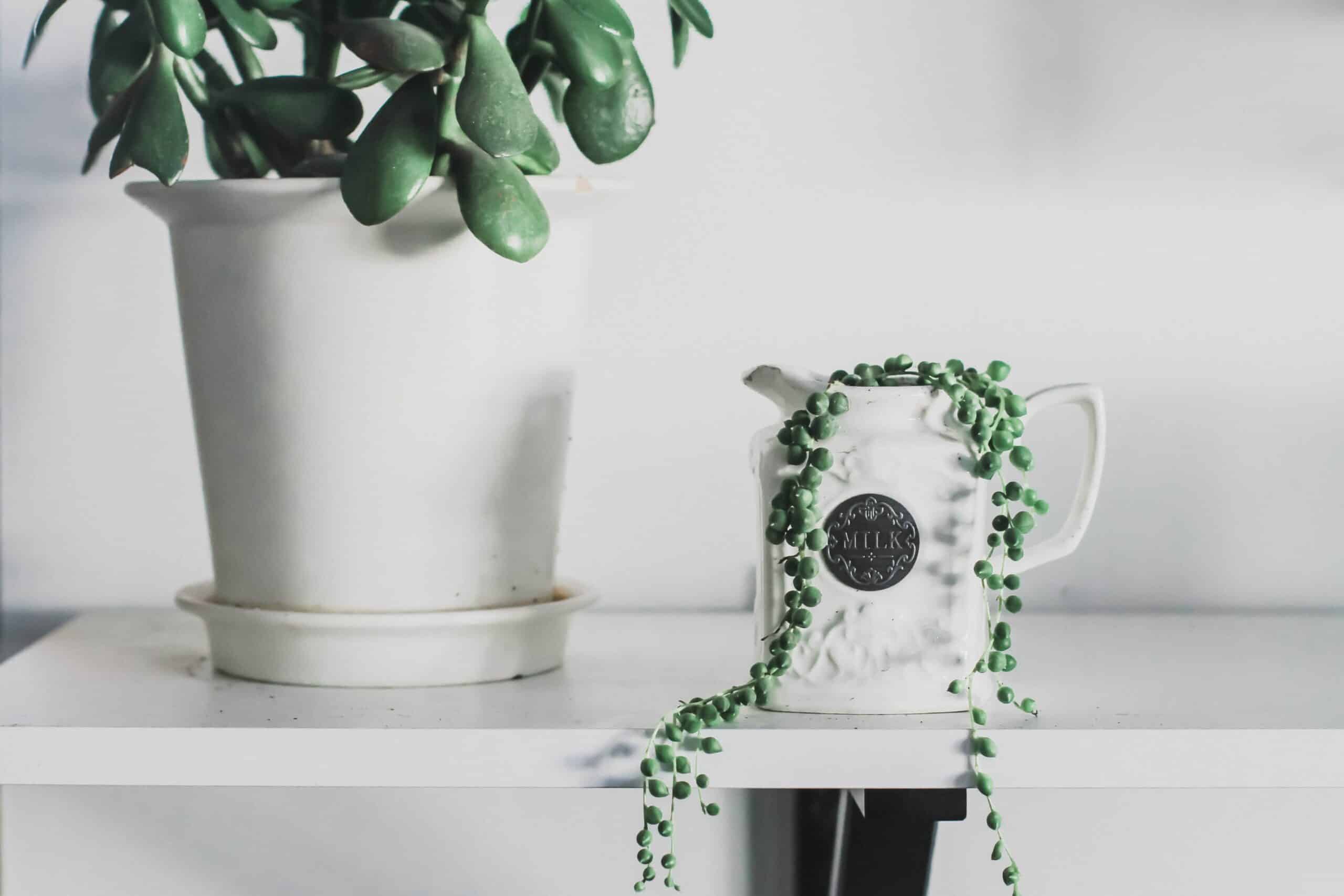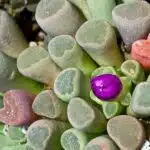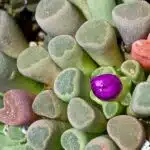Caring for a string of pearls plant is like taking a journey into the world of succulents. With its cascading, pearl-like leaves, this unique succulent is an unforgettable sight to behold. In order to make sure it thrives and continues to bring joy to your home or garden, you need to provide the right care and environment.
String of pearls plants are native to South Africa and can be found in many areas around the world. They have long stems with small bead-shaped leaves that resemble strings of pearly beads. The plants are also known for their ability to survive with limited water and light, making them perfect for those who don’t have a green thumb but still want to enjoy growing plants.
This article will cover everything you need to know about growing and caring for your string of pearls plant. From selecting the right potting soil and getting the right amount of sunlight, to watering schedules and tips on how to propagate your plant – it’s all here! Read on for more information on how you can get started on this fascinating journey into succulent gardening.
Understanding String Of Pearls Succulents
String of Pearls succulents are nothing short of spectacular! These unique plants have a charm that is absolutely mesmerizing, with their trailing stems and pearl-like leaves. An ideal choice for hanging baskets, String of Pearls is sure to be a conversation-starter in any home or office.
When it comes to growing and caring for this plant, there are several important points to keep in mind. The key to success is understanding its requirements and providing the right environment for it to thrive. Here are some tips on how to grow and maintain your String of Pearls succulents:
First, choose an appropriate location for the plant where it will receive bright indirect sunlight. This type of light mimics the natural conditions found in desert regions where these succulents originate from. They also prefer warm temperatures, so if you’re planning on keeping them indoors make sure they’re placed away from drafts and cold windowsills. Additionally, these plants need well-draining soil that is kept slightly moist but never soggy; water only when the surface is completely dry.
Generally speaking, String of Pearls succulents can tolerate periods of drought but regular watering promotes healthy growth and more vibrant foliage. With proper care and attention, these beautiful plants will reward you with their exotic charm for years to come! Moving forward, let’s look at how to choose the perfect String of Pearls plant…
Choosing A String Of Pearls Plant
When choosing a string of pearls plant, it’s important to consider the environment in which it will be grown. These succulents love bright light and require well-draining soil, as they are prone to root rot if kept in wet conditions. Look for a healthy specimen with plenty of green foliage and vibrant color when selecting a string of pearls plant.
The size and shape of the pot should be taken into consideration when purchasing a string of pearls plant, as these succulents can quickly outgrow smaller pots. A wide and shallow pot is ideal, as it allows for adequate drainage after watering. It’s also best to choose a container with at least one drainage hole in the bottom for excess water to escape.
String of pearls plants can often be purchased from local nurseries or flower shops but may also be available online from specialty retailers. When shopping online, look for reputable sellers who offer detailed descriptions and photos of the product being purchased. This helps ensure that the plant arrives healthy and ready to thrive in its new home.
Planting String Of Pearls
It’s time to get your hands dirty and start planting the string of pearls! As you ready yourself to bring these enchanting plants into your home, take a moment to appreciate their complexity. Like tiny strings of pearls, these plants have a rare beauty that captivates and mesmerizes.
When it comes time to plant, choose a potting mixture that is well-draining and contains soil, perlite or pumice, and sand. Make sure the pot has drainage holes in the bottom so extra water can escape. You’ll also want to use some sort of potting tray or saucer under the pot as this will catch any excess water to help prevent root rot.
Once the soil is prepared and placed in the pot, gently place the plant in its new home. Firmly press down on each side of the stem as you do so, making sure that all sides are firmly rooted in place. Add some more soil if needed until all sides are covered evenly. Finally, give it a light watering – just enough for the roots to absorb without becoming soggy – and you’re done! Now onto ensuring your string of pearls gets all the sunlight it needs!
String Of Pearls Soil Requirements
When it comes to growing your string of pearls plant, soil requirements are just as important as water and light. These succulents require well-drained soil in order to thrive. The best type of soil for a string of pearls is a cactus mix, which is usually composed of peat moss, perlite, and vermiculite. Adding some coarse sand or pumice can help improve drainage even further. It’s also a good idea to have a layer of gravel at the bottom of the pot before adding the soil to help with drainage too.
It’s essential that you avoid using regular potting soil for your string of pearls plant because it will hold too much moisture and cause the roots to rot. If you don’t want to use a cactus mix specifically designed for succulents, you can make your own mixture by combining equal parts regular potting soil and sand or perlite. This will provide adequate drainage while still retaining enough nutrients for the plant’s growth.
String of pearls plants also benefit from occasional fertilization during the warmer months when they are actively growing. Look for an organic fertilizer that contains nitrogen and other trace elements such as iron, zinc, magnesium, and calcium. Use this fertilizer about once every two weeks during active growth periods according to manufacturer directions for best results.
With the right kind of soil in place, your string of pearls plant should be on its way to success! Watering these succulents properly is key to their health so next we’ll look at what kind of requirements they have in terms of hydration.
String Of Pearls Water Requirements
Caring for a string of pearls plant is not difficult, but it does require a few simple steps. Watering your string of pearls succulent is a crucial part of the process. It’s important to get the balance right between letting the soil dry out and watering regularly. Here’s what you need to know about water requirements for this beautiful houseplant.
First off, it should be noted that string of pearls are native to areas with very little rainfall, so they don’t require much water overall. That being said, these plants will still benefit from having their soil moistened every once in awhile. During the growing season, which starts in mid-spring and ends in late fall, you should water your string of pearls about once a week or so. When you do give it water, make sure that the soil is completely saturated – this will help prevent rot and encourage root growth.
In wintertime when growth slows down and temperatures drop, reduce your watering schedule as well. Aim for only every other week or even less during this time to avoid over-watering your plant. Additionally, if you notice any signs of drooping or wilting leaves on your succulent then give it an extra drink – these are usually indicators that it needs more moisture in its environment.
With proper care and attention, your string of pearls plant can thrive and bring life to any corner of your home! Now let’s look at how light plays an important role in keeping this unique-looking succulent happy and healthy
String Of Pearls Light Requirements
The brilliant, golden rays of the sun dance off the shimmering surface of the String of Pearls plant. Its individual pearls glisten in the sunlight and its delicate leaves bask in the warm glow. The light requirements for this beautiful succulent are key to its survival and growth.
When it comes to light, more is not always better for the String of Pearls. It’s best to place it near a window that offers bright indirect light or filtered natural light, but not direct sunlight. Direct sunlight can cause sunburns on the leaves and will eventually kill your plant if exposed for too long. If you don’t have access to enough natural light, you can use grow lights instead.
If you want your String of Pearls to look lush and healthy, make sure it gets enough light! With just a few simple adjustments to your environment, your succulent should be able to thrive with ease. Now that we know about optimal lighting conditions, let’s move on to understanding fertilizer requirements for this gorgeous plant.
String Of Pearls Fertilizer Requirements
String of pearls plants, also known as Senecio rowleyanus, are an interesting and beautiful succulent that can be grown indoors or outdoors. To ensure your string of pearls grows well and stays healthy, you must provide the right fertilizer requirements. Let’s dive into this crucial step in growing a successful string of pearls plant!
Just like all other plants, String of Pearls needs fertilizer to grow and flourish. For best results, feed your String of Pearls every three weeks from spring through summer season with a low-nitrogen formula made for cacti and succulents. If you prefer organic fertilizers, use a liquid fish emulsion fertilizer diluted to half its recommended strength. In the winter season, you should reduce the amount of fertilizer to just once a month.
It is important not to overfertilize your String of Pearls as too much nitrogen can cause it to become leggy and weak. The key is to find the perfect balance between providing enough nutrients so that it grows healthy while avoiding overfeeding it. To check if your soil has enough nutrients before watering or fertilizing, use a pH soil test kit available at any garden center or online store.
Taking care of your String of Pearls is simple if you understand its fertilizer requirements and follow them accordingly. With proper care and maintenance, you can keep your String of Pearls looking lush and gorgeous throughout the year! Now let’s move on to addressing some common problems with this plant…
Common Problems With String Of Pearls
String of Pearls plants, also known as Senecio Rowleyanus, are generally easy to care for and maintain. However, they are still prone to common problems that can occur with any plant. In this section, we’ll take a look at some of the potential issues you may encounter with your String of Pearls plant.
The most common issue is root rot. This occurs when the soil has too much moisture and not enough air circulation. When this happens, the roots become waterlogged and eventually start to rot away. To prevent root rot, make sure to check the soil before watering and allow the top layer to dry out completely between waterings. Additionally, use well-draining potting mix that includes perlite or pumice for better air circulation.
Another issue to watch out for is spider mites or mealybugs. These tiny pests feed off the sap of your plant and can cause significant damage if left unchecked. To treat an infestation, spray your plant regularly with a solution of insecticidal soap or neem oil every two weeks until all signs of pests have disappeared. You should also inspect your plant closely for any signs of pests on a regular basis to catch them early before they spread further throughout the plant.
These are just a few of the most common issues you may encounter when caring for a String of Pearls plant. With proper care and attention, you should be able to keep your String of Pearls looking healthy and thriving for many years to come! Next up we’ll discuss how you can propagate new plants from existing ones.
Propagating String Of Pearls
Ah, propagating string of pearls – the part of plant care that we find totally effortless! After all, what could be simpler than splitting off a few stems and watching them grow into new plants? Sure, it may take some time and patience, but hey – that’s why they call it gardening!
But seriously: when propagating string of pearls, the key is to create a healthy environment for the cuttings. The best way to do this is to start with clean tools and sterile soil. To speed up root growth, you can also dip the stem ends in rooting hormone before potting them up. Once you’ve done that, all you have to do is water carefully (over-watering can cause rot) and keep an eye out for any signs of trouble like wilting or disease.
Propagating your own string of pearls plants is not only easy – it’s also a great way to expand your collection without breaking the bank! Plus, once they’re established in their new pots, they’ll need very little attention besides occasional watering and pruning. So don’t hesitate: why not give it a go today?
Repotting String Of Pearls
Repotting string of pearls is an important step in keeping this succulent healthy and encouraging its growth. This process should be done when the existing pot is overcrowded or roots are coming out of the drainage holes. It also helps to use a fresh, well-draining soil mixture that’s specific for succulents.
When repotting, it’s important to handle the plant with care. Gently remove it from its existing pot, being careful not to damage any of the stems or leaves. After placing it into its new pot, water thoroughly and make sure to keep an eye on how much moisture is retained in the soil.
String of pearls should be monitored for overgrowth, as too much can cause the plant to become weak and unbalanced. With regular pruning and trimming, you can help ensure your plant remains healthy and beautiful for years to come. Transitioning into the next step, controlling string of pearls growth will help you keep this unique succulent thriving!
Controlling String Of Pearls Growth
Controlling the growth of your string of pearls plant is essential for keeping this delicate succulent looking its best. It’s like having a wild, untamed lion in your living room–you want to keep it tamed and elegant. Like taming a lion, growing a beautiful string of pearls requires careful attention. Let’s take a closer look at how to do just that!
To begin with, you’ll need to understand how often the plant needs to be watered. Over-watering can lead to root rot and other issues, so it’s important to pay close attention to the soil in order to avoid any problems. You should water only when the soil is dry and give it just enough water so that it doesn’t become soggy or overly wet. Additionally, you should think about where you’re planting your string of pearls; a spot that gets too much direct sunlight can also damage the plant and cause it to wilt or die off quickly.
Finally, pruning is another great way to control the growth of your string of pearls without harming them. Pruning helps keep their shape by removing any overly long stems and encouraging more compact growth patterns. To do this, simply snip off any excess stems with scissors or shears from time to time. Doing so will help keep your plant healthy and looking its best!
Pruning String Of Pearls
Many people may be hesitant to prune their string of pearls plants. After all, it’s a delicate-looking succulent with its thin stems and small, round leaves. However, pruning is necessary to keep it healthy and encourage its growth. With the right techniques, you can easily prune your string of pearls without causing any damage.
When pruning your string of pearls plant, start by removing any dead or damaged stems using a pair of scissors or garden shears. Make sure to cut them off at their base near the soil. This will help prevent further damage from spreading throughout the plant. Then, use a small pair of sharp scissors or tweezers to pinch off any new growth that’s too long and straggly for your taste. Doing this will promote bushier and healthier growth in the future.
Finally, if you want a fuller look for your string of pearl plant, consider propagating it by taking stem cuttings from existing plants and planting them in new pots filled with well-draining soil mix. To ensure success, make sure the cuttings are 4-6 inches long and have at least two sets of leaves on each piece before planting them. This way you’ll have an even fuller looking string of pearls in no time! Transitioning into drying and preserving these succulents is just as important as caring for them while they’re alive; read on to learn more about how to do it properly.
Drying And Preserving String Of Pearls
Preserving and drying string of pearls can be likened to a delicate dance. Each step must be done with great care in order for the plant to flourish once more. This section will help guide you through the process of preserving and drying your string of pearls.
The first step is to make sure that the soil is completely dry before harvesting the plant. When the leaves start to feel brittle and easily break off when touched, it’s time to remove them from the pot. Gently pick each leaf off one at a time so as not to damage any other foliage or stems. After you have removed all of the leaves, set them aside in a cool, dry place away from direct sunlight.
The second step is preserving your harvested string of pearls leaves by simply brushing away any dirt or dust that may have collected on them during harvesting. You can use a soft brush such as an old toothbrush or even a cotton swab for this task. Once clean, lay each leaf on a flat surface and allow it to dry completely before storing it away in an airtight container.
With careful steps taken, your string of pearls harvest should last for months if stored properly in dark and dry conditions until ready for replanting come springtime. Now that you know how to preserve and dry your string of pearls plant, let’s move on to preparing for winter care!
String Of Pearls Winter Care
The winter months can be a difficult time for succulents, like the string of pearls. While our little pearls may seem delicate and fragile, they are surprisingly resilient and with a few simple tips, you can keep them in tip-top shape throughout the cold season.
Winter care for your string of pearls is all about avoiding excess moisture. Don’t water them too often; if the soil is dry to the touch, it’s time to give your plants a drink. But don’t go overboard; let them dry out completely between waterings so as not to rot their roots. Additionally, move your plants away from cold drafts or windowsills to avoid frost damage in colder climates.
When temperatures dip below freezing, it’s best to insulate with burlap or some other kind of barrier material to protect against frostbite. Your string of pearls will need protection from these harsh conditions if you want them to thrive during the winter months. With these steps in mind, you’ll be sure that your precious pearls make it through unscathed and ready for spring growth!
String Of Pearls Companion Planting
String of Pearls companion planting is an important part of caring for this succulent. When planted with other succulents, the String of Pearls can create a beautiful combination of textures and shapes. However, there are some considerations to keep in mind before pairing these plants together.
When deciding which companion plants to choose, be sure to select ones that share similar water and light needs. Succulents like cacti and jade plants do well when paired with String of Pearls because they both require bright sunlight and infrequent watering. Additionally, be mindful when it comes to spacing the plants out – they should have at least a couple inches between them in order to avoid crowding or competing for resources like light and water.
Finally, although String of Pearls doesn’t need much fertilizer, adding a bit here and there can help promote healthy growth. When it comes time to fertilize your succulent companions, make sure that you use a diluted fertilizer solution that won’t burn their roots or leaves. With careful consideration and proper care, you can create a beautiful display of companion planted succulents!
Frequently Asked Questions
How Often Should I Water My String Of Pearls Plant?
Watering your string of pearls succulent is a delicate balance between too much and too little. The key to keeping this plant happy and healthy is to provide just the right amount of hydration. It’s like finding a pearl in an ocean – you have to know when to stop searching!
The frequency of watering needed will depend on many factors, such as the weather, temperature, and humidity levels in your region. Generally speaking, during the growing season, it’s best to water them every week or two. Make sure to check the soil first: if it’s already moist, then skip that week. If it feels dry, give them a good soaking until water runs through the drainage holes at the bottom of the pot.
In wintertime, when temperatures drop and growth slows down, reduce watering accordingly. They can usually go for up to a month without being watered; however, if you live in an area with very low humidity levels or your home stays especially warm inside during wintertime, you may need to water them more frequently. As always – observe your plant carefully over the course of several weeks and adjust the watering schedule as needed so that they stay healthy and beautiful all year round!
What Is The Best Way To Propagate String Of Pearls?
Propagating a string of pearls plant can be a rewarding experience and an excellent way to ensure that the beautiful cascading succulent continues to thrive. An easy way to propagate is by taking cuttings from the existing plant. To do this, carefully use clean pruning shears or scissors to snip off a few inches from the stem. It’s best to take multiple cuttings just in case some of them don’t take root.
In order for the cuttings to grow roots, it is important to let them dry out for several days before planting in soil. This gives time for the ends of the stems to form calluses, which are protective layers that help prevent infections and allow roots to develop more easily. Once dried, place each cutting in fast-draining potting soil and water regularly until they begin to grow new leaves and stems.
To ensure success when propagating string of pearls plants, it is important to provide adequate light and warmth. Place your cuttings in bright filtered light and keep temperatures between 65-70 degrees Fahrenheit (18-21 Celsius). If you follow these tips, you can enjoy watching your new plants start growing in no time!
Is String Of Pearls Toxic To Pets?
It is understandable to be concerned about the potential toxicity of any living organism around pets, especially when it comes to string of pearls plants. Though these succulents are popular houseplants, it is important to investigate whether they could be harmful to furry friends. It is possible that one may have worries regarding this question.
Fortunately, one can take relief in the knowledge that this particular plant is not toxic to cats or dogs. This means that if pets happen to ingest any part of the plant, it will not cause any serious harm. In spite of this fact, however, it is still wise for pet owners to exercise caution and ensure that their beloved animals cannot access the string of pearls plant as much as possible.
Therefore, one does not need to worry about possible negative consequences for their pets due to contact with this captivating succulent species. Instead, pet owners can rest easy knowing that string of pearls plants are safe for their companions and can be enjoyed without reservation in any home environment.
How Long Does It Take For String Of Pearls To Grow?
“Time and tide wait for none”, an adage which holds true for all aspects of life. The same is true when it comes to growing a String of Pearls succulent, a dainty and attractive plant that’s popular among gardeners everywhere. So how long does it take for this particular species to grow? Let us find out.
The growth rate of the String of Pearls depends on several factors, including the type of soil, light availability, and water supply. It usually takes 4-6 weeks for the plant to become established, and then it will begin to spread its tendrils along the ground or hanging container. As far as total time needed to reach full maturity, it usually takes about 3-4 months until the vines are full and lush with foliage.
The most important thing when caring for a String of Pearls is to provide adequate light and moisture levels while keeping in mind that too much of either can be detrimental to its health. Pruning should also be done regularly to ensure that growth remains healthy; pruning helps keep the stems from becoming too dense or tangled. With proper care and attention, you can easily have a thriving String of Pearls in your home or garden in no time at all!
Are String Of Pearls Plants Good For Indoor Or Outdoor Use?
The String of Pearls plant is a stunning succulent that can add beauty and texture to any garden. But one question many gardeners have is: are String of Pearls plants suitable for indoor or outdoor use? Let’s take a closer look to find out.
This hardy little succulent is surprisingly versatile when it comes to location. It can thrive in both outdoor and indoor environments, so long as the conditions are right. For outdoor gardens, the plant needs well-draining soil, plenty of sunshine, and regular watering. Indoors, it will enjoy bright light from an east or west facing window and occasional misting with water to keep its soil moist. As if a Strings of Pearl’s unique appearance wasn’t enough, this flexibility makes it an even more attractive choice for gardeners everywhere!
String of Pearls plants are like pearls in the rough – easy to care for and absolutely beautiful! With the right amount of sunlight and moisture they’ll make any space shine while providing an eye-catching conversation starter. Whether you choose to place them indoors or outdoors, these low maintenance succulents will bring joy with their graceful vines of pearl-shaped foliage.
Conclusion
The String of Pearls plant is a rare and fascinating specimen that can be grown both indoors and outdoors. With proper care, it can thrive in many climates and provide beautiful foliage. When watering your plant, make sure not to overwater as this can lead to root rot. Propagation through stem cuttings is the easiest way to grow more String of Pearls plants. While these plants are not toxic to pets, they should still be kept out of reach to prevent accidental ingestion. With regular trimming and pruning, a new String of Pearls plant will take anywhere from six months to two years before it reaches its full size.
Overall, the String of Pearls plant is an intriguing succulent with unique characteristics that make it an attractive addition to any garden or home. It requires minimal maintenance but needs attention and care if it’s going to remain healthy and vigorous for many years to come. Though the process may seem daunting at first, anyone with a bit of patience can create a stunning display of cascading pearls with just a few simple steps!





























